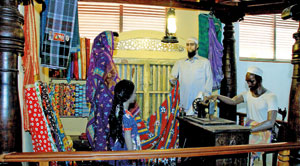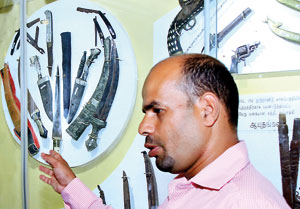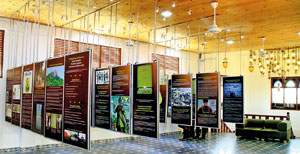Through the mists of time our Moor heritage
View(s):By Chandani Kirinde

Authentic display: A tailoring shop recreated. Pix by Indika Handuwala
Sri Lankan Moors have a rich and proud history dating back centuries. They have been closely associated with Sinhala kings starting from the time of King Pandukabaya who ruled around 370 BC and through the years of colonial rule as well as in the post-colonial era. The town of Kathankudy, about three miles south of Batticaloa is where some of the oldest Moor settlements took root and today this town is home to the Heritage Museum, a fitting tribute to the Muslim community in the country.
Located in the heart of the Kathankudy town, the four-storey Heritage Centre, opened recently, houses around 1,500 artifacts and historical records of the early life of the Moors on the island. These are meant to familiarise visitors with the lifestyle of the Muslim community during the pre-colonial, colonial and post-colonial era, their religious practices and customs. The Heritage Museum also pays tribute to Muslim heroes who have contributed to the country’s struggles during different periods in its history including the struggle for independence from British rule.
Drawn from historical records that detail the arrival of pre-Islamic Arabs to Sri Lanka as well as from other research done tracing the lineage of the Muslim community, the Museum brings to light many little known facts about the contribution of the community towards the development and wellbeing of the country.
“Along with the history of the Muslim community in the country, this Museum is meant to highlight the contribution they have made over the centuries to enrich its rich and diverse culture and particularly enhance trade,” said Abdul Raheem Jazmil who is in charge of the Heritage Centre.

Raheem Jazmil
The display panels in the Museum tell the story of the arrival of the Moors as well as the story of individuals who have left a lasting imprint on the country’s history.
One of the panels quotes V. Vamadevan who in his book “The story of the Sri Lanka Muslims” states, “In the fifth century some shipwrecked Moors from the Malabar Coast, landed at a spot called Poonochchimunai, about three miles south of Batticaloa. From the ship they spied in the distance, a thin column of smoke from the settlement of Veddas. Seeing that the new territory was beautiful and plenteous, they settled at Kathankudy, the present most thickly populated Moor village in Sri Lanka.”
The trading skills of the Muslim community and how these helped the country’s economy to thrive in the days of yore too are told both through ancient exhibits as well as illustrated by historian Dr.Lorna Dewaraja in her book, ‘The Muslims of Sri Lanka, One Thousand Years of Ethnic Harmony’. In her book, Dr. Dewaraja illustrates how in the days of Arab commercial prosperity, the Giants’ Tank (Yoda wewa built by King Dhatusena (450-473)) which was near Mantota was maintained in perfect condition and irrigated large tracts of fields in the neighbourhood. “In the Dry Zone, agriculture was entirely dependent on irrigation and constant vigilance, manpower and economic resources were needed to maintain the efficient functioning of the hydraulic system. The surplus wealth came largely from foreign trade which was in the hands of the Arabs and hence Arab trade was vital to the country’s economy,” she writes.
There is also reference made to sacrifices made by members of the community. One such is the story of a Muslim lady from the village of Paranagammana, who chose death at the hands of the Portuguese than betray the hiding place of the King of Kandy Rajasinghe (1636-1687) who had come there to hide from the colonisers who were looking to kill him.
“When the King escaped with his life, he was stricken with grief on hearing the tragic episode of the faithful woman who sacrified her life for the sake of the King. As a tribute to her memory, a large extent of land was gifted to the Muslims to live in the village of Paranagammana in the Uva Province,” one of the panels says quoting from “Glimpses of the Historic Past” by C.M.Austin de Silva.

Full of information: Panels depicting different episodes in history
There is of course, the more well-known story of Police Constable Mohamed Sabhan, who made the ultimate sacrifice in the pursuit of well-known bandit Saradiel and his gang members falling victim to a gunshot at Mawanella on March 21, 1864. Police Heroes’ Day is commemorated each year since then on this day in recognition of police personnel killed while on duty. A special area in the Heritage Museum is dedicated to this local hero.
The Museum also displays the everyday life of members of the Muslim community during the 16th and 17th Century with replicas on display including a house, a bazaar where Muslim traders marketed and sold their goods and wares including gems and pearls; a religious school as well as a replica of an olden day mosque of clay and sticks with a cadjan roof. Ancient handwritten script from the holy book of the Muslims- the Koran as well as those written on Ola leaf too can be seen at the Heritage Centre.
The Museum was the brainchild of State Minister for Rehabilitation and Resettlement M.L.A.M.Hizbullah and its building was funded under the Deyata Kirula programme of the previous government. The Museum is now operational and is maintained by the Department of Archaeology even though more work remains to be done on dating some of the artifacts as well as having the display signs written in all three languages.
The Heritage Centre is open six days a week except on Friday from 9 a.m. to 6 p.m.


